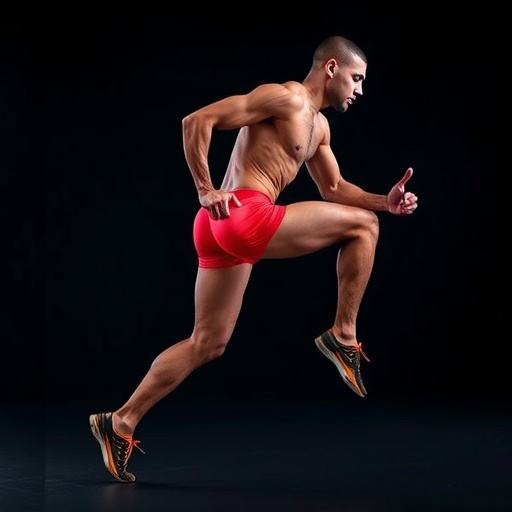In a groundbreaking study recently published in Scientific Reports, researchers delve into the intricate relationship between targeted hip abductor fatigue and its impact on biomechanical performance during single-leg landing actions. This research is critical in understanding how fatigue affects athletic function, particularly in sports and activities demanding precision and strength. The findings present new insights into the musculoskeletal adjustments that occur when athletes experience fatigue, offering implications for injury prevention, rehabilitation, and athletic training.
Fatigue is a common factor encountered by athletes, particularly during high-intensity sports. It is known to compromise performance, leading to increased risk of injury. The hip abductors, a group of muscles that play a crucial role in maintaining stability and alignment during dynamic movements, are often under great strain during explosive sports actions. Their fatigue, therefore, raises concerns regarding biomechanical alterations that could predispose athletes to lower limb injuries. Thus, this study sets out to investigate these effects comprehensively.
The study involved a cohort of trained athletes who performed single-leg landing tasks under two conditions: one with rested hip abductors and another following induced fatigue. Fatigue was elicited through a series of controlled exercises aimed at the hip abductor muscles. The mechanics of their landings were quantitatively analyzed using advanced motion capture technology, capturing variations in trunk and lower limb biomechanical parameters critical to overall coordination and control.
The results yielded significant findings. When the hip abductors were fatigued, there were notable changes in trunk and lower limb mechanics. Specifically, researchers observed alterations in joint angles, ground reaction forces, and loading patterns during the landing phase. These biomechanical shifts highlight the negative repercussions of muscular fatigue, suggesting that athletes may compromise their stability and increase the likelihood of injury when fatigued.
One of the most striking observations was the role of the trunk in maintaining overall postural stability. The trunk acts as a central link between the lower and upper body. When the hip abductors were fatigued, the trunk exhibited compensatory strategies that could lead to maladaptive movement patterns. This relationship emphasizes the critical need for athletes to focus on both muscle endurance and overall body mechanics to maintain performance integrity.
Interestingly, the study found that the fatigue-induced changes were not uniform across all participants. While some athletes displayed substantial biomechanical deviations, others maintained relatively stable mechanics despite fatigue. This suggests an underlying variability in how individuals respond to fatigue, influenced by factors such as prior training, muscle conditioning, and individual anatomical differences. Coaches and trainers might consider these variables when developing training regimens and recovery strategies.
The implications of these findings extend beyond athletic performance; they also offer a window into injury prevention strategies. Understanding how fatigue impacts biomechanics can guide the development of targeted training programs focused on enhancing muscle endurance. By bolstering the strength and endurance of hip abductors, athletes may be able to retain proper mechanics even in fatigued states, thereby reducing the risk of injury.
Additionally, this research underscores the importance of rehabilitation protocols for injured athletes. Professionals must consider not only the injured muscle but also the entire kinetic chain. The interdependence of hip, trunk, and lower limb mechanics necessitates a holistic approach to recovery, ensuring that athletes regain full functional performance post-injury.
As the sports science community continues to explore these critical areas, the use of technology in biomechanical analysis is becoming more pervasive. Advanced motion capture systems provide valuable insights into movements that are otherwise difficult to quantify. Moreover, wearable technologies are emerging, allowing for real-time feedback on muscle performance and workload. This integration of technology into training practices represents a paradigm shift in how athletes can monitor and manage their performance levels.
Future research inspired by this study could further explore the connection between upper body dynamics and lower limb mechanics. Understanding how the kinetic chain operates during high-intensity movements will enrich our grasp of athletic performance and inform further studies on fatigue management. Researchers could also investigate gender differences in biomechanical responses, providing a more nuanced understanding of how fatigue affects male and female athletes differently.
In conclusion, the study conducted by Harato et al. provides crucial insights into the biomechanical adjustments made by athletes during single-leg landings under conditions of muscle fatigue. It vividly illustrates the delicate interplay between hip abductor performance and the stability of trunk and lower limbs during dynamic athletic movements. As the field of sports science progresses, this research paves the way for enhanced training protocols, focused on muscle endurance and biomechanical stability, ultimately promoting safer and more effective athletic performance.
Subject of Research: The impact of targeted hip abductor fatigue on trunk and lower limb biomechanics during single-leg landing.
Article Title: Targeted hip abductor fatigue alters trunk and lower limb biomechanics during Single-Leg landing.
Article References:
Harato, K., Nishizawa, K., Imai, S. et al. Targeted hip abductor fatigue alters trunk and lower limb biomechanics during Single-Leg landing.
Sci Rep 15, 36268 (2025). https://doi.org/10.1038/s41598-025-20279-0
Image Credits: AI Generated
DOI: 10.1038/s41598-025-20279-0
Keywords: hip abductors, fatigue, biomechanics, athletic performance, injury prevention, muscle endurance.




